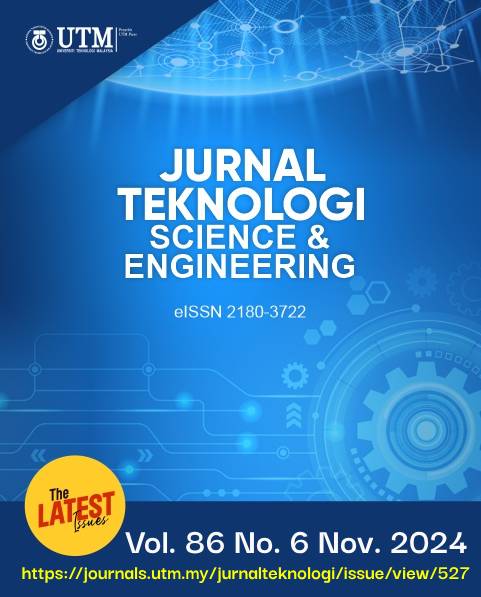THE IMPACT OF POST-WELD HEAT TREATMENT ON RE-WELDING IN SHIELDED METAL ARC WELDING JOINT ST42 STEEL
DOI:
https://doi.org/10.11113/jurnalteknologi.v86.20316Keywords:
Re-welding, post-weld heat treatment, ST42 Steel, SMAWAbstract
Re-welding is a technique used to repair welds that are deemed defective and in danger of causing harm. Post-weld heat treatment is a method for improving welding-induced residual stresses, microstructural changes, hardness, and toughness. This work investigated the influence of post-weld heat treatment on the mechanical characteristics of ST 42 steel re-welding utilizing the SMAW technique and E6013 filler. Four samples with varying degrees of rewelding and post-welding treatment were analyzed. Based on the result, re-welding using SMAW to the St42 steel material led to a 20-40% decrease in mechanical properties, with the most significant reduction observed in the modulus of elasticity after two re-welding cycles. Conversely, post-weld heat treatment (PWHT) applied to the St42 steel subjected to two re-welding processes resulted in a 6-20% increase in mechanical properties, notably a 20% increase in the modulus of elasticity. These findings underscore the effectiveness of PWHT in enhancing mechanical properties, particularly microstructure recovery, in materials that have undergone re-welding.
References
A. F. Zakki and S. Jokosisworo. 2012. Analisa Kekuatan Tarik Penyambungan Pelat dengan Ketebalan Berbeda pada Type Sambungan Butt Joint. Kapal: Jurnal Ilmu Pengetahuan dan Teknologi Kelautan. 5(3): 152-158.
N. M. Hunter and H. W. Townshend. 1935. Shipbuilding by Welding. Nature. 136(3449): 906-907. Doi: 10.1038/136906c0.
R. W. Jr. Messler. 2004. Chapter 6 – Welding as a Joining Process.
S. Bruni and F. Braghin. 2009. 15 - Effect of Damage on Vehicle Dynamics. In Lewis and U. Olofsson (Eds.), Wheel–Rail Interface Handbook (456-476). R. Woodhead Publishing. Doi: https://doi.org/10.1533/9781845696788.1.456.
M. F. Mat, A. F. Musah, A. G. Tham, and S. A. Sulaiman. 2015. Evaluation of Rail Head Surface Repair using smaw Process with Pre Heating Condition. J Teknol. 76(6). Doi: 10.11113/jt.v76.5682.
O. Popovic and R. Prokic-Cvetkovic, "Surface Welding as a Way of Railway Maintenance," in Mechanical Engineering, M. Gokcek, Ed., Rijeka: IntechOpen, 2012, p. Ch. 10. doi: 10.5772/35403.
S. Shinichi, R. Muraoka, T. Obinata, E. Shigeru, T. Horita, and K. Omata. 2004. Steel Products for Shipbuilding. JFE Technical Report.
J. Billingham. 1994. Steel: A Versatile Advanced Material in Marine Environments. Ironmaking & Steelmaking. 21: 452-458.
H. Lücken, A. Dr.-Ing. Kern, and U. Schriever. 2008. High-Performance Steel Grades for Special Applications in Ships and Offshore Constructions. International Offshore and Polar Engineering Conference, Canada.
N. Bailey. 1994. 2 - Potential Welding Problem Areas. In N. Bailey (Ed.), Weldability of Ferritic Steels (45–53). Woodhead Publishing. Doi: https://doi.org/10.1533/9781845698935.45.
M. Stewart. 2021. 11 - Tubular Heat Exchanger Inspection, Maintenance, and Repair. In M. Stewart (Ed.), Surface Production Operations (555-668). Boston: Gulf Professional Publishing. Doi: https://doi.org/10.1016/B978-0-12-803722-5.00011-2.
J. E. M. Braid and J. A. Gianetto. 1986. The Effects of pwht on the Toughness of Shielded Metal Arc Weld Metals for Use in Canadian Offshore Structure Fabrication. In Welding Institute of Canada (Ed.), Welding for Challenging Environments (145-155). Pergamon. Doi: https://doi.org/10.1016/B978-0-08-031866-0.50018-4.
J. C. F. Jorge et al. 2019. Influence of Welding Procedure and PWHT on HSLA Steel Weld Metals. Journal of Materials Research and Technology. 8(1): 561-571. Doi: 10.1016/j.jmrt.2018.05.007.
L. D. J. Jorge et al. 2018. Mechanical Properties and Microstructure of SMAW Welded and Thermically Treated HSLA-80 Steel. Journal of Materials Research and Technology. 7(4): 598-605. Doi: 10.1016/j.jmrt.2018.08.007.
H. N. Farneze, J. C. F. Jorge, L. F. G. de Souza, and I. de S. Bott. 2010. Comparative Study of High-strength steel Weld Metals Obtained by the SMAW and FCAW Processes for Offshore Applications and Mooring Chains. Welding International. 24(12): 903-910. Doi: 10.1080/09507110903568943.
A. J. M. Gomes, J. C. F. Jorge, L. F. G. de Souza, and I. de Souza Bott. 2013. Influence of Chemical Composition and Post Welding Heat Treatment on the Microstructure and Mechanical Properties of High Strength Steel Weld Metals. Materials Science Forum. 758. Doi: 10.4028/www.scientific.net/MSF.758.21.
J. R. Davis and Davis & Associates. 1996. ASM Specialty Handbook - Carbon and Alloy Steels. In ASM Handbooks Series. OH: ASM International. https://books.google.co.id/books?id=RnNoQgAACAAJ
M. Stewart. 2021. 11 - Tubular Heat Exchanger Inspection, Maintenance, and Repair. In M. Stewart (Ed.), Surface Production Operations (555-668). Boston: Gulf Professional Publishing. Doi: https://doi.org/10.1016/B978-0-12-803722-5.00011-2.
ASTM International. 2013. E8/E8M - 13a Standard Test Methods for Tension Testing of Metallic Materials. Doi: 10.1520/E0008_E0008M-13A.
ASTM International. 2014. E290 - 14 Standard Test Methods for Bend Testing of Material for Ductility. Doi: 10.1520/E0290-14.
ASTM International. 2016. E23−16b: Standard Test Methods for Notched Bar Impact Testing of Metallic Materials. Doi: 10.1520/E0023-16B.
Biro Klasifikasi Indonesia. 2022. Rules for Welding. In Part 1 Seagoing Ships. www.bki.co.id.
R. Selvabharathi. 2019. Effect of Post Weld Heat Treatment and TiAlSiN Coating on the Tensile Strength of Autogenous Plasma Arc Welding of Duplex/super Austenitic Stainless Steels. J Manuf Process. 38: 135-147. Doi: 10.1016/j.jmapro.2019.01.008.
C. M. Lin, H. L. Tsai, C. Der Cheng, and C. Yang. 2012. Effect of Repeated Weld-repairs on Microstructure, Texture, Impact Properties and Corrosion Properties of AISI 304L Stainless Steel. Eng Fail Anal. 21: 9-20. Doi: 10.1016/j.engfailanal.2011.11.014.
N. A. Raji and O. O. Oluwole. 2012. Effect of Soaking Time on the Mechanical Properties of Annealed Cold-Drawn Low Carbon Steel. Materials Sciences and Applications. 03(08): 513-518. Doi: 10.4236/msa.2012.38072.
I. Oladele, D. Alonge, T. Betiku, A. Barnabas, and S. Shittu. 2019. Distinctiveness of Welding Joints Design Based on Mechanical and Corrosion Environmental Influence on Low Carbon Steel. Advanced Technologies & Materials. 44(2): 13-19. Doi: 10.24867/atm-2019-2-003.
H. Schönmaier, C. Fleißner-Rieger, R. Krein, M. Schmitz-Niederau, and R. Schnitzer. 2021. On the Impact of Post Weld Heat Treatment on the Microstructure and Mechanical Properties of Creep Resistant 2.25Cr–1Mo–0.25V Weld Metal. J Mater Sci. 56(36): 20208-20223. Doi: 10.1007/s10853-021-06618-2.
Downloads
Published
Issue
Section
License
Copyright of articles that appear in Jurnal Teknologi belongs exclusively to Penerbit Universiti Teknologi Malaysia (Penerbit UTM Press). This copyright covers the rights to reproduce the article, including reprints, electronic reproductions, or any other reproductions of similar nature.
















